| |
|
|
The Catholic Church considered the
Jews pestilent for fifteen hundred years, put them in
ghettos, etc, because it recognized the Jews for what
they were .... I recognize the representatives of this
race as pestilent for the state and for the Church ...
|
|
Adolf Hitler, 26 April 1933
|
Without centuries of Christian anti-Semitism, Hitler's passionate
hatred would never have been so fervently echoed.
Robert Runcie (1921-2000), Archbishop of Canterbury (1980-1991)
Early Christians specialised in causing trouble at synagogues
and disrupting Jewish services. Such behaviour had been censured
by the pagan emperors, but under Christian ones official censure
changed to toleration and even encouragement. The first nominally
Christian emperor, Constantine, was also the first significantly
to limit the rights of Jews as citizens of the Roman Empire.
He imposed heavy penalties on anyone who converted to Judaism
and also on any Jewish community that received converts. In
the next generation any Christian converting to Judaism would
have all of his property confiscated. Marriages between Christians
and Jews became capital offences. In later centuries the emperors
became more strongly Christian, and the laws concerning Jews
became correspondingly more discriminatory, intolerant and oppressive.
An important turning point came in 388. In that year Christians
burned a synagogue at Rome and the authorities required that
restitution be paid. This was clearly fair and in keeping with
custom. But in the same year Christians razed another synagogue,
at Callinicum on the Euphrates, at the instigation of the local
bishop. Again the Emperor required the bishop to make restitution.
The leading churchman of the day, Ambrose, now a saint and Doctor
of the Church, interceded and made it clear to the Emperor that
it would be sinful to help the Jews in this way*.
The Emperor acceded to the will of the Church and withdrew his
demand for justice.
The Christian Emperor Theodosius II promulgated a new code
of law in 438 that excluded Jews from all political and military
functions. They were again forbidden to marry Christians, to
own Christian slaves, to hold public office or to build synagogues.
In the same year the Empress Eudocia tried to relax the regulations
that barred the Jews from Jerusalem except for the festival
of Sukkoth. When the Jews gathered on the Temple Mount, Christian
monks on the Mount revealed swords and clubs hidden under their
robes and attacked the Jews. Many were murdered. When eighteen
of the monks were brought for trial, the leader of the massacre,
a monk called Barsoma, assembled his followers again and spread
rumours that noble Christians were to be burned alive. Now they
threatened to burn the Empress herself and inspired such fear
that the proceedings had to be dropped. "Five hundred groups"
of paramilitary monks patrolled the streets. Barsoma announced
that "The cross has triumphed". He later became St
Barsoma.
St John Chrysostom, another
Doctor of the Church, was even more extreme. He claimed that
Jews sacrificed their children to Satan , an accusation that
was to be amplified and believed throughout Christendom for
centuries. He also claimed that God hated the Jews and always
had done. His eight sermons of 387 whipped congregations into
a frenzy of excitement and fanaticism: Jews were drunkards,
whoremongers and criminals. They were lascivious, obscene, demonic
and accursed. They murdered prophets, Christ, even God himself.
Before long the sort of massacre of Jews by Christians, which
in time would come to be known as pogroms, were being instigated
by Christian leaders. St Jerome
regarded the Jews as vipers. St Cyril, Bishop of Alexandria,
instigated a series of riots directed against them. Massacres
and riots occurred elsewhere in the Empire but, as so often,
surviving records are patchy, and have been so sanitised by
Christian hands that they are unreliable. We shall almost certainly
never know how many Jews were murdered by Christians during
the Dark Ages.
Under Justin I (Eastern Roman Emperor 518-527), Jews were forbidden
to make wills, to receive inheritances, to give testimony in
court, or to perform any other legal act. From now on they would
be second class citizens. The next emperor, Justinian, produced
a new code in 529 confirming their legal disabilities. This
code would be influential for many hundreds of years. Marriage
between Christian and Jew was confirmed as a capital offence.
Synagogues were sequestered and converted into churches. The
burning down of synagogues was also explicitly made legal. Many
bishops and monks — now saints — took advantage of
the revised law to commit acts of arson. In 538 a Church Council
at Orléans again condemned intermarriage. It prohibited
Christians and Jews eating together, or mixing at all during
Holy Week. Regulations affected all facets of life. Jews were
not permitted to give medical aid to Christians or to receive
it from them. By the end of the sixth century they were being
subjected to forcible baptism. A Church Council in Toledo in
694 declared all Jews to be slaves. Their possessions were to
be confiscated and their children seized — to be converted
to Christianity. By 1010 local Jewish populations were being
routinely massacred in Europe, notably in Rome, Orléans,
Rouen, Limoges, and throughout the Rhineland. Existing legal
disabilities were confirmed by the Third Lateran Council in
1179, which added a further restriction that Jews should not
receive feudal homage. Christians living with Jews were to be
excommunicated — a regulation leading directly to the creation
of Jewish ghettos. Cannon law expressly prohibitted ordinary
social relationships with Jews:
None may eat, live, or receive medical treatment with Jews.
Let neither clergy or laity eat their unleavened bread, live
with them, call them in when they are sick, receive medicine
from them, or wash with them at the baths. If anyone does
this, let him be deposed if a cleric, and excommunicated if
a lay person.
(Decretum gratiani, Case 28, q I, C13)
The justification for Jewish persecutions through the centuries
has been a passage from the Matthew gospel. After Pilate has
denied responsibility for sentencing Jesus to death, the Jewish
people are quoted as saying " ...His blood be on us, and
on our children" (Matthew 27:25). A similar theme may be
found at 1 Thessalonians 2:15. In Christian eyes this meant
that the Jews as a race were collectively responsible for the
death of Jesus. In time, the principle of collective guilt would
open the way to the assignment of other imaginary forms of guilt.
The fact that Jesus had been a Jew, as his parents and his followers
had been, was overlooked. In Christian art the Jews were depicted
as ugly and deformed, while Jesus was a handsome European.
|
Jesus (with his cross) and St Veronica
looking European while their fellow citizens
conform to the traditional Christian characature of Jewish
appearance.
Bearing Of The Cross, Hieronymus Bosch (1462-1516), Musée
des Beaux Arts, Ghent
|
|
|
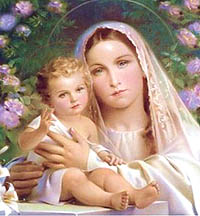  In
western European art Jesus" family were often depicted
with blond hair and blue eyes. The suggestion that Jesus might
have looked anything like a typical Mediterranean Jew was tantamount
to blasphemy. He was invariably depicted wearing at least a
loincloth, not only to protect emerging concepts ofChristian
modesty, but also to hide the uncomfortable fact that he had
been circumcised, as all Jewish boys were (and still are), at
the age of 8 days (Luke 2:21). The apostles were also depicted
as handsome western Europeans — all except Judas who was
shown with caricatured Jewish features and who alone wore the
yellow clothes that Jews were obliged by medieval Christians
to wear. Artistic depictions of Satan also tended to show him
with caricatured Jewish facial features. In
western European art Jesus" family were often depicted
with blond hair and blue eyes. The suggestion that Jesus might
have looked anything like a typical Mediterranean Jew was tantamount
to blasphemy. He was invariably depicted wearing at least a
loincloth, not only to protect emerging concepts ofChristian
modesty, but also to hide the uncomfortable fact that he had
been circumcised, as all Jewish boys were (and still are), at
the age of 8 days (Luke 2:21). The apostles were also depicted
as handsome western Europeans — all except Judas who was
shown with caricatured Jewish features and who alone wore the
yellow clothes that Jews were obliged by medieval Christians
to wear. Artistic depictions of Satan also tended to show him
with caricatured Jewish facial features.
The greatest Christian leaders in the Medeval period shared
an intense anti-Semitism. One of the greatest, Peter the Venerable
considered Jews as no better than animals. In fact Jews are
not just animals but beasts of burden. In a tract A Tract Against
The Inveterate Hardness of the Jews, arguing for the divinity
of Christ, he repeats the point over and over: Here he is addressing
a Jew:
It seems to me, Jew, that I ... judge in these matters ...
as do all men. And if all men, then you also - if, nevertheless,
you are human. For I dare not declare that you are human lest
perchance I lie, because I recognize that reason, that which
distinguishes humans from ... beasts, is extinct in you or
in any case buried.... Truly, why are you not called brute
animals? Why not beasts? Why not beasts of burden? ... The
ass hears but does not understand; the Jew hears but does
not understand. Am I the first to say this? Has not the same
been said many centuries before [by your prophet]? ... And
although it is fully proved by these sacred authorities that
you are a domestic animal or beast ... and it has been sufficiently
shown by me, nevertheless yet a fifth chapter will be added
that shall expose, not only to Christians but to all the lands
of the world, that you are truly a beast of burden and that,
when I affirm this, I in no way exceed the bounds of truth.*
  A
provision in Deuteronomy 23:20 permitted Jews to make a profit
from lending money to gentiles. So it was that Jews were able
to lend money in Christian Europe. This suited both Jews and
Christians, and Jews were allowed into Christian countries in
order to fulfil an essential economic function. As far as is
known, Jews were introduced into Britain soon after the Norman
Conquest to act as bankers to the King and his nobles. They
were regarded as the King's property*,
and in theory enjoyed his protection. Restricted to money lending,
Jews were frequently accused of usury, although their rates
of return were a fraction of those of modern high-street banks.
They were routinely cheated, abused and humiliated, and the
most preposterous calumnies were perpetrated against them. A
provision in Deuteronomy 23:20 permitted Jews to make a profit
from lending money to gentiles. So it was that Jews were able
to lend money in Christian Europe. This suited both Jews and
Christians, and Jews were allowed into Christian countries in
order to fulfil an essential economic function. As far as is
known, Jews were introduced into Britain soon after the Norman
Conquest to act as bankers to the King and his nobles. They
were regarded as the King's property*,
and in theory enjoyed his protection. Restricted to money lending,
Jews were frequently accused of usury, although their rates
of return were a fraction of those of modern high-street banks.
They were routinely cheated, abused and humiliated, and the
most preposterous calumnies were perpetrated against them.
During Eastertide of 1144 a 12-year-old boy by the name of
William was murdered near Norwich, probably by a local sexual
deviant. Contrary to the available evidence, a monk, Thomas
of Monmouth, formulated a theory that the boy had been ritually
murdered by Jews. He claimed that they had crucified him just
as they had crucified Jesus, overlooking the fact that crucifixion
was a Roman not a Jewish practice, and that there was no reason
to suppose that the child had been crucified at all. Nevertheless,
the story soon gained wide currency and came to be believed
as fact. William was acclaimed St William, a martyr for the
Holy Mother Church. His body was moved to Norwich Cathedral,
where wondrous miracles were worked at his shrine, a circumstance
that served to confirm the monk's story. Norwich profited enormously
from the influx of pilgrims, all eager to learn the details
of St William's dreadful martyrdom, to witness his great miracles,
and to make offerings.
|
During the excavation of a site in the
centre of NorwichIn in 2004, researchers discovered the
bodies of 17 people thrown head first into a Norwich well.
Later study by a team from the University of Dundee identified
them as Jewish. Eleven of the 17 skeletons were those
of children aged between two and 15. The remaining six
were adult men and women. There is evidence the children
were thrown down the well after the adults.The positions
in which they were found indicated many of them had been
dropped into the well from their ankles. Seven skeletons
were successfully tested and five of them had a DNA sequence
suggesting they were likely to be members of a single
Jewish family. No cause of death other than being dropped
into well was apparent in any of the skeletons. The bodies
are most likely those of Jewish victims of a Christian
Pogrom. Likely dates for the massacre are 1144 and the
1230's both follwing outbreaks of the Christian blood
libel against Jews. (http://www.bbc.co.uk/news/uk-13855238)
|
|
|
As the stories spread and Norwich became rich, it must have
occurred to others that they could cash in on anti-Semitism
as well. In any event, there was an outbreak of such cases around
the country — Gloucester 1168, Bury St Edmunds 1181, Winchester
1192. The victims of any and every child murderer were acclaimed
by the Church as victims of Jewish atrocities. Shrines were
established, pilgrims arrived, miracles occurred, and the money
rolled in. When the Bishop of Norwich visited France in 1171,
similar cases were suddenly reported there as well — Blois
1171, Pontoise and Braisne 1182. Another case was reported in
Saragossa in the same year. Any murder without a genuine suspect
was likely to excite a new outbreak of unfounded rumour. When
the body of a nine-year-old boy called Hugh was discovered down
a well in Lincoln in 1255, the stories of ritual murder were
soon circulating again. Jews were accused of crucifying him
in the most unlikely circumstances*.
After torture sessions and a show trial, 19 Jews were executed
and many more suffered other punishments. Chaucer's Prioress's
Tale gives a chilling insight into Christian thinking about
Little St Hugh (as the boy is now known), and demonstrates the
use of anti-Semitic propaganda in skilled hands.
|
Christian propaganda found on an Exchequer
Roll, a document that lists tax payments made by the Jews
of Norwich in 1233, during the reign of King Henry III.
Isaac fil Jurnet, a Jewish moneylender
from Norwich who was banker to King Henry, sued the monks
at Westminster to recover interest on money they had borrowed
after they refused to pay it. This illustration refers
to this event. The three-headed monster with the crown
towering over the center of the drawing is Isaac. The
man and woman facing each other beneath Isaac, with Satan
between them, are Mosse Mokke and his wife Abigail, both
of whom were employed by Isaac. On the left a poor Christian
monk, protects a set of scales full of coin that Isaac
is trying to wrest from him, using one of the many devils
at his command.
|
|
|
Sometimes there was not even a murder victim to trigger the
anti-Semitism. At Blois a servant of the mayor reported that
he thought he saw a Jew throw a child's body into the river.
No body was ever found, and no child was reported missing. Even
so, 38 leading Jews were sentenced to death and were burned.
The calumny of ritual child sacrifice, which came to be known
as the blood libel, was soon widespread throughout
Europe. Jews were accused of torturing children, murdering them
in a ritual parody of Christian belief, then drinking their
blood. Everywhere, Jews suffered torture and death because of
these inventions.
|
Eighteenth century painting on the wall
of St. Paul's Church, Sandomierz, Poland (detail)
Paintings like this were popular in Catholic churches
throughout western Christendom for many centuries. Most
disappeared quietly in the twentieth century, but a few,
like this one, survived on public display in traditionalist
areas into the twenty-first century.
The picture shows verious aspects of
the blood libel. On the right a Jew is paying a woman
for a fresh child-victim, who is being assessed by another
Jew, in front of them, dressed in red. Another child is
being tortured in the top left, and other infants lie
on the floor apparently having been crucified. In the
centre three Jews pour blood into a drinking cup from
a barrel containing a butchered child. Left-over limbs
are fed to a dog in the bottom left, having been drained
of blood.
|
|
|
As the King's property, Jews in England had enjoyed a measure
of protection. But when kings started taking their Christian
duties seriously, they became less inclined to take care of
their Jews. Jewish citizens who came bearing gifts for Richard
I at his coronation in 1190 were massacred out of hand. Their
murder was acclaimed by churchmen as the judgement of God and
was emulated in almost every other town in England with a Jewish
community. When a massacre broke out in York, the Jewish population
took refuge in a substantial building called Clifford's Tower.
There, their Christian neighbours besieged them, offering a
choice between death and Christian baptism. Many chose to die
by their own hand. Others gave themselves up to the Christians
only to be massacred on the spot, despite the promises. Those
who had led the siege and massacre went to nearby York Minster,
where they burned records of their debts to the people they
had just murdered. Then they left for the Third Crusade, safe
in the knowledge that the Church would forgive them, if indeed
it felt it needed to. Groups of Jews were massacred by zealous
Christians on a number of occasions like this.
|
A sign within Clifford's
Tower in York (2014)
the site of the wooden keep where Jews committed suicide
rather than convert to Christianity
|
|
|
| |
|
A reconstruction of the events at Clifford's
Tower in York in 1190
(photo taken at Clifford's tower 2014)
|
|
|
| |
|
A memorial at the base of the motte of
Clifford's Tower reads:
On the night of 16th March 1190 some
150 Jews and Jewesses of York having sought
protection in the Royal Castle on this site
from a mob incited by Richard Malebisse
and others chose to die at each other's hands
rather than renounce their faith
|
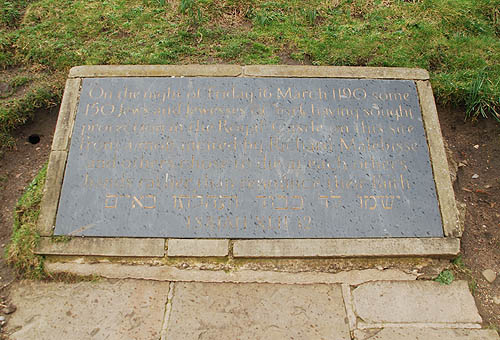 |
Jews suffered a number of indignities and disabilities. The
Fourth Lateran Council in 1215 had debarred them from holding
land, and from all military and civil functions. It had also
required all Jews to wear distinctive clothing. At the insistence
of the Church they were obliged to fast during Lent. They were
debarred from practising almost all trades, since trades were
controlled by guilds. Guilds were essentially Christian organisations:
they enjoyed the favours of patron saints; their members built
chapels; they put on annual religious plays. They would not
permit Jewish members, and without membership it was impossible
to obtain an apprenticeship, or to sell services. Boroughs obtained
royal charters to allow them to exclude Jews from their environs.
By 1271 the requirements of the Church were being enforced in
England, and Jews were prevented from holding land*.
They were also obliged to wear distinctive yellow badges, as
they were in continental Europe.
It is sometimes claimed that anti-Semitism was a European phenomenon,
rather than a Christian phenomenon. But this is demonstrably
not so. In the ninth century senior churchmen like Agobard ,
Archbishop of Lyons, and Hinemar, Archbishop of Rheims, worked
hard campaigning against Jews who were already integrated into
Carolingian society. In Muslim Spain and in Cathar lands of
the Languedoc, Jews had enjoyed much greater freedom than in
Christendom. In Cathar lands they were accorded civil rights
and sat as elected consuls. They filled high offices for the
Counts of Toulouse and other potentates. The Easter tradition
called "Strike the Jew", popular throughout Western
Christendom, had been abolished in Toulouse in the middle of
the twelfth century — despite the protests of the clergy*.
One of the specific charges made by churchmen against Raimon
VI of Toulouse was that he gave public office to Jews. In 1209,
stripped to the waist and barefoot, he was obliged to swear
in front of a relic-laden altar, in the presence of 19 bishops
and three archbishops, that he would no longer allow Jews to
hold public office. In 1229 his son and heir, Raimon VII, underwent
a similar ceremony where he was obliged to prohibit the public
employment of Jews, this time at Notre Dame in Paris*.
By the next generation a new, zealously Roman Catholic, ruler
was arresting and imprisoning Jews for no crime, raiding their
houses, seizing their cash, and removing their religious books.
They were then released only if they paid a new "tax"*.
As an English historian of the crusade against the Cathars puts
it:
Organised and official persecution of the Jews became a normal
feature of life in the south only after the Crusade because
it was only then that the Church became powerful enough to
insist on the application of positive measures of discrimination*.
Again, the Spanish Inquisition worked hard to introduce anti-Semitism
into areas of Spain where Judaism, Islam and Christianity had
coexisted for centuries under convivencia. They introduced
ghettos, enforced sumptuary laws, promoted mass expulsions,
and encouraged racial discrimination*.
In Jeruasalem Christians sought and obtained from the Moslems
rulers the right to kill Jews for the crime of walking past
a church, or the convent on Mount Zion. Unaware Jews were routinely
lynched for this crime, a position that continued until 1917*.
Like Richard I, King Edward I was a crusader. His duty to God
impelled him to travel to the Levant to kill God's enemies,
the Muslim infidels. It occurred to him, as it occurred to other
crusaders, that it was much easier to kill off God's other enemies,
the perfidious Jewish infidels, without even crossing the English
Channel. The problem was that they were funding the National
Debt. Eventually, to save himself from financial ruin, Edward
confiscated the whole of their property, and expelled them from
the country in 1290. Even so, Christian propaganda kept alive
the calumnies, and centuries later English audiences would have
been familiar with usurers like Shylock in The Merchant
of Venice. Jews were not readmitted to England until Cromwell's
Protectorate and then not because of any sympathy for them,
but in order to facilitate the End of the World*.
They continued to suffer a number of legal disabilities up to
the nineteenth century. Even after 600 years the blood libel
was still current in Britain. It surfaced for example during
the spate of Jack the Ripper murders in Whitechapel in 1888.
The murders were quite different from the ones in the Middle
Ages, and the charges of ritual murder were equally absurd,
but they sounded just as convincing to receptive ears.
In Europe, as in England, Jews were generally protected by
the rulers whom they served, but if their usefulness ceased,
or the debts owed to them became too great to repay, they became
dispensable. Time after time their property was confiscated
and they were exiled — for example from France in 1182,
1306 and 1396 , Parma in 1488, Milan in 1490, and Spain in 1492.
All the nobles had to do was withhold protection, and enthusiastic
Christian hands would do the rest. Pogroms were a feature of
European life throughout the Crusades everywhere. During the
Shepherd's Crusade of 1251 the Jewish population of southern
France was almost annihilated.
The blood libel was popular almost everywhere. In 1285, 180
Jews were burned in Munich following a rumour that they had
bled a child to death in their synagogue. In 1294 the blood
libel was heard at Bern in Switzerland. Some Jews were executed,
the rest expelled from the city. Later a fountain was erected
showing a sinister-looking Jew eating one child and carrying
a sack full of others. In 1475 most of the Jews in the town
of Trent in the Tirol were tortured and burned following reports
that a child had been ritually murdered. On Easter Sunday, March
26th, 1475, the corpse of a young boy called Simon was found
floating in a ditch in the city of TrentThe Christian population
had been whipped into a murderous frenzy by a preacher, Fra
Bernardino da Feltra, who had accused Jews of ritual murder
in his Lenten sermons that year. The Church duly beatified Simon,
and the usual selection of miracles were reported at his shrine.
His cult continued officially until 1965, and there are still
Catholics propagating the traditional blood-libel around Simon's
death*.
|
"Beatus Simon Martyr" (The
blessed martyr Simon) Engraving, Nürnberg,, ca.1479
Note the imagined instruments of torture in the foreground,
the auriole around Simon's head, and the amputated limbs
of Simon's supposed murderers in the background.
|
|
|
| |
|
here Simonino de Trento (Simon of Trent)
is shown being tortured and murdered by a number of named
Jews. He was declared blessed by the Catholic Church,
but all mention of him and his fictitious martyrdom were
removed by the Church in 1965.
|
|
|
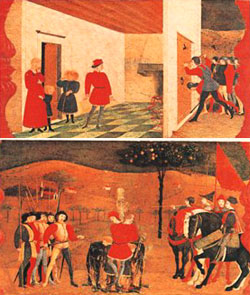  The
doctrine of transubstantiation affirmed by the Fourth Lateran
Council in 1215 led Roman Catholics to believe that the bread
used at the Mass changed into Jesus" flesh. The word host,
a term for a sacrificial victim, was (and still is) applied
to this bread. Within a few years stories were spreading that
Jews were stealing wafers of bread and torturing them in order
to torture Jesus. A common story was that they pushed nails
through the bread, making it bleed in imitation of the crucifixion,
a practice known as host nailing. Sometimes the breadeven
cried out in pain. Stories like this led to Jews being sent
to the stake throughout Europe, the first victims apparently
in 1243 at Berlitz in Germany. In 1298 a host-nailing story
was spread by a priest at Nuremberg, as a result of which 628
Jews lost their lives. In 1337 at Deggendorf in Bavaria the
entire Jewish population was burned following the circulation
of such stories. The Church there commissioned a number of paintings
showing Jews torturing the host with thorns, and with hammers
and nails. Thousands of pilgrims travelled to see these pictures,
until they were withdrawn in the 1960s. The
doctrine of transubstantiation affirmed by the Fourth Lateran
Council in 1215 led Roman Catholics to believe that the bread
used at the Mass changed into Jesus" flesh. The word host,
a term for a sacrificial victim, was (and still is) applied
to this bread. Within a few years stories were spreading that
Jews were stealing wafers of bread and torturing them in order
to torture Jesus. A common story was that they pushed nails
through the bread, making it bleed in imitation of the crucifixion,
a practice known as host nailing. Sometimes the breadeven
cried out in pain. Stories like this led to Jews being sent
to the stake throughout Europe, the first victims apparently
in 1243 at Berlitz in Germany. In 1298 a host-nailing story
was spread by a priest at Nuremberg, as a result of which 628
Jews lost their lives. In 1337 at Deggendorf in Bavaria the
entire Jewish population was burned following the circulation
of such stories. The Church there commissioned a number of paintings
showing Jews torturing the host with thorns, and with hammers
and nails. Thousands of pilgrims travelled to see these pictures,
until they were withdrawn in the 1960s.
|
A painted glass window in Brussels Cathedral
showing Jews nailing hosts. Pictures like this were very
popular in churches up until themid 1960's, but almost
all of them have mysteriously disappeared, so only fixed
items like windows remain.
|
|
|
    Similar
massacres took place elsewhere, and imaginative pictures werecommissioned
to lend credibility to the imaginary events that had precipitated
them. Generally they showed blood flowing from the tortured
wafers of bread. In 1453, a total of 41 Jews were burned to
death at Breslau after a woman reported seeing a Jew stab a
wafer. Confessions were obtained by the use of torture. Such
confessions led to the burning of 27 Jews at Mecklenburg in
1492. The last known execution of Jews for host nailing took
place at Nancy in 1761. Similar
massacres took place elsewhere, and imaginative pictures werecommissioned
to lend credibility to the imaginary events that had precipitated
them. Generally they showed blood flowing from the tortured
wafers of bread. In 1453, a total of 41 Jews were burned to
death at Breslau after a woman reported seeing a Jew stab a
wafer. Confessions were obtained by the use of torture. Such
confessions led to the burning of 27 Jews at Mecklenburg in
1492. The last known execution of Jews for host nailing took
place at Nancy in 1761.
|
Desecration of the Host by Jews in Bratislava
by Mayer Lucas, (Staatliche Museen Preußischer Kulturbesitz)
- telling the usual host desecration narrative - front
left > front right > mid cetre & back left
|
|
|
|
Details from the above - on the left
Jews are cutting hosts, which bleed. On the right they
are executed for their crimes.
|
 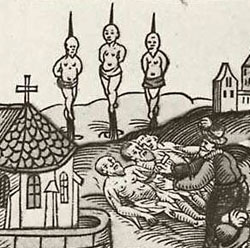 |
|
Details from another sequence (from a
15th-century German woodcut of the supposed host desecration
by the Jews of Passau, 1477) showing the host desecration
by Jews (dentified by the badges the Church requires them
to wear), and the subsequent torture to elicit confessions
and the names of their (supposed) conspirators - red hot
pincers and burning the feet
|
 |
|
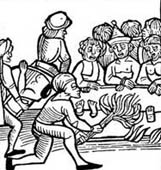 |
Another fanciful idea was that Jews plotted to poison wells.
In Bohemia, 86 Jews were accused of this in 1161 and burned
at the stake. At Chinon in 1321, a total of 160 Jews were burned
as accomplices of the lepers who had supposedly planned to poison
the whole of France. Some years earlier, 40 Jews had committed
suicide at Vitry in order to avoid the same fate. When the Black
Death ravaged Europe between 1348 and 1351, Jews provided convenient
scapegoats. The theory was that they provoked it by poisoning
water wells. Now it was the Jews who were primarily held responsible,
and the lepers who were the accomplices. At Strasbourg 2,000
Jews were burned alive. At Mainz some 6,000 were slaughtered
in a single day, the 24 th August 1349. Elsewhere Jews were
walled up in their homes and left to die of starvation. Around
10,000 Jews, representing around 80 communities, were murdered
in Bavaria. The entire Jewish population of Basel was wiped
out: 600 adults went to the stake; their children were given
to Christians for forcible conversion. Invariably the Church
was involved one way or another, sometimes through priests,
sometimes monks, sometimes through a rampaging mob of penitents
known as Flagellants. These Flagellants literally whipped themselves
into a religious frenzy. They were responsible for a Jewish
massacre at Frankfurt in July 1349. Sometimes their mere approach
precipitated violence. Anticipating the arrival of Flagellants
in the same year, Christians at Brussels killed 600 Jews. Within
the space of the three years 1348-1350, there were 350 known
Jewish massacres, but there may well have been many more.
As in England, Continental crusaders often started with a massacre
of local Jews when they set off for the Holy Land. On their
way to the First Crusade in 1095-6, various groups, fired by
the oratory of preachers, massacred any Jews that they came
across. A group in Normandy attacked Jews in Rouen. A priest
called Volkmar led a group of Saxon crusaders in the massacre
of Jews in Prague. Another priest, called Gottschalk, led the
massacre of Jews in Regensburg. Crusaders from Flanders attacked
Jews in Cologne. A group from Lorraine attacked those in Metz.
Another group attacked Jews in Speyer, Worms and Mainz. In Worms
around half the Jewish population was slaughtered. The survivors
asked the local bishop to save them. He said he would do so
only if they agreed to become Christians, and left them to consider.
As happened in other such situations in towns throughout Europe,
they committed mass suicide rather than convert. The men killed
their children, then their wives (one a new bride), then each
other. The last man left alive then killed himself. Successful
crusades not only started with massacres of Jewish communities,
they ended with them as well. The general pattern followed the
first great crusader success. When the crusaders took Jerusalem
they pursued the Jewish population into their synagogue, and
then set light to it, burning them alive.
Sprees of murder and arson were led by priests , and the same
pattern was repeated every time a new crusade was preached.
As one influential abbot, Peter of Cluny, pointed out: it was
expensive in men and money to travel to the end of the world
to fight Mohammedans, yet there were infidels living locally
who were far more guilty towards Christ. The implication is
that it would be much cheaper, easier, safer, and worthier to
massacre local Jews than to attack distant Muslims — who
were likely to fight back. Preachers promoting the Second Crusade
prompted massacres across Germany and France.
  Jewish
literature was also a common target. Book burning was widespread
and endorsed by the Church. Pope Gregory IX ordered the Talmud
to be burned throughout Christendom. Tens of thousands of copies
of it, together with other rabbinical writings, were destroyed.
One reason for this orgy of destruction was the suspicion that
the Talmud contradicted Christian beliefs concerning the Virgin
Birth of Jesus. The crusader king, Louis IX of France ( St Louis),
was also worried by the danger of Jews denying the Virgin Birth.
If Christian laymen heard a Jew denying the Virgin Birth, or
otherwise slandering the Christian faith, they should, said
the future saint, run him through with a sword on the spot. Jewish
literature was also a common target. Book burning was widespread
and endorsed by the Church. Pope Gregory IX ordered the Talmud
to be burned throughout Christendom. Tens of thousands of copies
of it, together with other rabbinical writings, were destroyed.
One reason for this orgy of destruction was the suspicion that
the Talmud contradicted Christian beliefs concerning the Virgin
Birth of Jesus. The crusader king, Louis IX of France ( St Louis),
was also worried by the danger of Jews denying the Virgin Birth.
If Christian laymen heard a Jew denying the Virgin Birth, or
otherwise slandering the Christian faith, they should, said
the future saint, run him through with a sword on the spot.
Like other minority groups — prostitutes, Muslims, lepers
and reformed heretics — Jews were required to wear distinctive
clothing to act as a "badge of infamy". In France
and Spain this was generally a round yellow patch called a rouelle.
In Italy rouelles, circular red badges and yellow hats were
all used. In England it was a saffron badge shaped like the
twin tablets of Moses. In Germany, Austria and Poland, Jews
traditionally wore a pileum cornutum, a conical hat
known in German as a Judenhut. Pope Gregory IX complained
about this non-conformity in 1233 in a letter to the German
bishops, and an effort was then made to bring them into line
and wear badges. Jews were required to pay an annual fee for
their rouelles, so they were effectively being required to pay
for being persecuted ).
|
The Catholic Church required members
of various persecuted minorities to wear distinctive badges
- "badges of infamy" - an idea adopted and adapted
by the Nazis.
|
|
|
Persecution was popular at all levels within the Church, but
the main proponents were the mendicant orders — Dominicans
and Franciscans. They invented pretexts to justify persecution,
they ran the Inquisition, they enforced the rules, they promoted
the burning of Jews and Jewish writings, they engineered ever
more severe restrictions, they encouraged forcible conversion,
and they preached anti-Semitism to the populace. They acted
against Jews and other minority groups as "the shock troops
of the Church"*.
Popes also promoted the persecution of Jews. Callistus III (pope
1455-1458) for example revived legislation prohibiting social
contacts between Christians and Jews. Paul IV (pope 1555-1559)
hated them. As a cardinal he had ordered the burning of Jewish
books. Two months after his election as Pope he published his
bull Cum nimis absurdum, a document that was to promote
anti-Semitism for centuries to come. He claimed that Jews were
slaves by nature, and that they should be treated as such. In
Rome, and throughout the Papal States, they were confined to
specified districts each with a single entrance, which are now
known as ghettos. (The term ghetto is taken from the
name of the district in Venice where the Senate had confined
the Jews in 1516.) Jews were forced to sell their houses at
a fraction of their worth, forbidden to engage in commerce,
and obliged to wear badges of infamy in public. They were obliged
to use Latin, and to attend Church sermons for their conversion.
The only trade open to them was the buying and selling of second-hand
clothes and old iron — which largely explains why Jews
were traditionally associated with the rag and bone trade. Once
again, Jews were forbidden to receive medical attention from
Christians. Synagogues were destroyed. Paul's restrictions were
enforced more or less severely by popes for many centuries.
Elderly Jews were kidnapped from their ghetto during the Roman
Carnival, forced at sword point to overeat, then to race against
each other. If two Christians testified that a Jew had insulted
the Roman Catholic faith, or a priest, he could be put to death.
Neither was this sort of attitude restricted to the Middle Ages.
Leo XII (pope 1823-1829) once again forcibly confined the Jews
to ghettos and subjected them to the Inquisition. His Holiness
also condemned a new Austrian Constitution because it countenanced
Jews running their own schools and colleges. As late as 1852,
Pope Pius IX had persuaded Tuscany to prohibit Jewish physicians
from practising medicine.
|
Memorial at Ribadavia, Galicia, Spain.
It says "In memory of the residents of this village
condemned by the Inquisition for their beliefs four hundred
years ago"
|
|
|
  Roman
Catholic authorities had for centuries been forcibly removing
Jewish children from their parents in order to bring them up
as Christians. The whole civilised world was shocked to discover
that this was still happening in 1858 when Edgardo Mortara was
seized in Bologna and sent to Rome (see page 353). His Holiness
refused to yield to world opinion and, after a triumphal parade
through the ghetto in Rome, Edgardo began his new life. (The
Church's argument was that several years earlier a Christian
maid had secretly baptised the infant Edgardo when he was thought
to be dying, so he was already a Christian.) In future the Church
would be much more circumspect in removing children from their
parents, though it continued to do so well into the twentieth
century. As for the ghettos, it was not until 1870 (when Italian
troops forcibly took Rome — the last remnant of the Papal
States) that Jews were released from the last ghetto in Europe.
One of the first acts of the new Kingdom of Italy after the
liberation of Rome was to tear down the ghetto walls. Roman
Catholic authorities had for centuries been forcibly removing
Jewish children from their parents in order to bring them up
as Christians. The whole civilised world was shocked to discover
that this was still happening in 1858 when Edgardo Mortara was
seized in Bologna and sent to Rome (see page 353). His Holiness
refused to yield to world opinion and, after a triumphal parade
through the ghetto in Rome, Edgardo began his new life. (The
Church's argument was that several years earlier a Christian
maid had secretly baptised the infant Edgardo when he was thought
to be dying, so he was already a Christian.) In future the Church
would be much more circumspect in removing children from their
parents, though it continued to do so well into the twentieth
century. As for the ghettos, it was not until 1870 (when Italian
troops forcibly took Rome — the last remnant of the Papal
States) that Jews were released from the last ghetto in Europe.
One of the first acts of the new Kingdom of Italy after the
liberation of Rome was to tear down the ghetto walls.
Wherever Christianity flourished, so did anti-Semitism. A clerical
revival in France in the 1890s was linked to the Dreyfus affair,
during which a Jewish army officer was falsely accused of treason
by the Christian establishment. It was left to a small number
of freethinkers such as Émile Zola to help Dreyfus, as
it was to help other Jews when falsely accused. When it became
clear that a miscarriage of justice had taken place, La
Civiltà Cattolica commented that "if a judicial
error has indeed been committed, then the Assembly of 1791 was
responsible when it accorded French nationality to Jews".
Father Vincent Bailly, Editor of La Croix, claimed
that the Church in France was undergoing "a punishment
reminiscent of Christ's own passion .... betrayed, sold, jeered
at, beaten, covered with spittle and crucified by the Jews".
The Dreyfus affair and its repercussions were indirectly responsible
for the introduction of the 1905 law separating church and state
in France.
  Anti-Semitism
was still widespread at the beginning of the twentieth century.
In Limerick in Ireland the Jewish community were boycotted,
stoned, beaten and robbed, and eventually driven out of the
city in 1904. The man behind it was Father John Creagh, a priest
who accused Jews each Sunday from his pulpit of a range of offences
from deicide (god-murder) to conspiracy with Freemasons. Included
was the accusation that Jews were given to murdering Christians,
an echo of the old blood libel*.
The Protocols of the Learned Elders of Zion, a fabrication
created by a Russian Orthodox secret policeman revived Christian
anti-Semitism throughout Europe. In England it was republished
in 1920 by the official publishers to the Church of England*. Anti-Semitism
was still widespread at the beginning of the twentieth century.
In Limerick in Ireland the Jewish community were boycotted,
stoned, beaten and robbed, and eventually driven out of the
city in 1904. The man behind it was Father John Creagh, a priest
who accused Jews each Sunday from his pulpit of a range of offences
from deicide (god-murder) to conspiracy with Freemasons. Included
was the accusation that Jews were given to murdering Christians,
an echo of the old blood libel*.
The Protocols of the Learned Elders of Zion, a fabrication
created by a Russian Orthodox secret policeman revived Christian
anti-Semitism throughout Europe. In England it was republished
in 1920 by the official publishers to the Church of England*.
Jews were persecuted in eastern Europe as well as western Europe.
Hundreds of thousands were murdered in Christian pogroms in
eastern Europe over the centuries. In 1723 the Bishop of Gdansk
in Poland demanded the expulsion of Jews from the city. When
the city authorities declined, he exhorted a mob to break into
the city ghetto and beat the residents to death. Such pogroms
continued until recent times. Often the murders were justified
by the old blood libel. Familiar charges of the ritual murder
of children were heard from the Protestant court chaplain, Adolf
Stöcker, at Berlin in 1892, and again at the Hilsner trial
in Slovakia in 1900, and at the Beilis trial in Kiev in 1913.
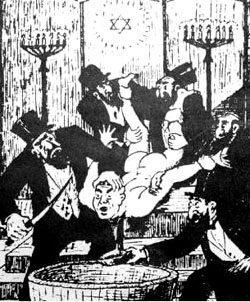  The
general pattern is that the stronger the Christian faith, the
stronger is the persecution of the Jews. It is notable that
pogroms have been common in Poland during intervals of that
country's independence, when the Church has enjoyed its greatest
power and influence. The restoration of independence to Poland
in 1918, for example, was followed by an immediate return to
traditional practices — an outbreak of pogroms. Polish
Roman Catholics may not have welcomed domination by Hitler's
Third Reich but few quarrelled with the Nazi's attitude towards
the Jews. Many Roman Catholics in Poland saw their Jewish neighbours
carted off to death camps and were often not at all averse to
helping them on their way*.
In some places local Catholics carried out their own pogroms,
as at Jedwabne where hundreds of Jews were burned alive in 1941*.
After the War, when Jewish refugees returned to their homes
and businesses, Christian Poles reacted in the traditional way
once again. They circulated stories of the ritual murder of
children — the ancient blood libel yet again — and
instigated a massacre of the refugees. At Kielce 42 Jews, some
of them recently freed from Nazi death-camps, were murdered
by their Christian neighbours*. The
general pattern is that the stronger the Christian faith, the
stronger is the persecution of the Jews. It is notable that
pogroms have been common in Poland during intervals of that
country's independence, when the Church has enjoyed its greatest
power and influence. The restoration of independence to Poland
in 1918, for example, was followed by an immediate return to
traditional practices — an outbreak of pogroms. Polish
Roman Catholics may not have welcomed domination by Hitler's
Third Reich but few quarrelled with the Nazi's attitude towards
the Jews. Many Roman Catholics in Poland saw their Jewish neighbours
carted off to death camps and were often not at all averse to
helping them on their way*.
In some places local Catholics carried out their own pogroms,
as at Jedwabne where hundreds of Jews were burned alive in 1941*.
After the War, when Jewish refugees returned to their homes
and businesses, Christian Poles reacted in the traditional way
once again. They circulated stories of the ritual murder of
children — the ancient blood libel yet again — and
instigated a massacre of the refugees. At Kielce 42 Jews, some
of them recently freed from Nazi death-camps, were murdered
by their Christian neighbours*.
Like their Roman Catholic brethren, Orthodox Christians thrived
on anti-Semitism for centuries. In the Ukraine, for example,
numerous massacres were perpetrated in the mid-seventeenth century.
Orthodox Ukrainians took the opportunity to massacre some 100,000
Jews, representing around 300 communities, while rebelling against
their Polish rulers. In 1801, Orthodox priests in Bucharest
used the traditional blood libel to whip up Christian sentiment,
which resulted in the Jewish quarter being attacked, and 128
inhabitants having their throats cut. In the 1840's blood libels
arose on Damascus, Rhodes and Jerusalem. In Damascus Jews were
arrested for supposedly killing a Christian monk. Sixty three
Jewish children were tortured to induce their mothers to reveal
the "hiding place of the blood". In Jerusalem a Christian
boy attacked a Jewish boy. The Jewish boy threw back a stone
which grazed the Christian's foot. This was enough for Orthodox
churchmen to accuse Jews of procuring Christian blood to add
to their passover biscuits. Jewish persecutions were common
under the Russian Orthodox Church right up to the Russian Revolution
of 1918. Cossacks and other Orthodox troops killed around 60,000
Jews in eastern Europe during the Revolution itself.
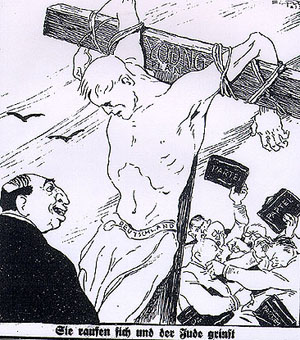  Protestants
also found Jewish persecution and genocide to be entirely compatible
with their faith. After all the New Testament had referred to
Jews as children of the Devil (John 8:44), and Martin Luther
had regarded Jews as "worse than devils"
and a “damned, rejected race" He recommended
how they should be treated: "Set their synagogues on fire
... in order that God may see that we are Christians .... Their
homes should likewise be broken down and destroyed .... They
should be put under one roof or in a stable, like gypsies, in
order that they may realize that they are not masters in our
land, as they boast, but miserable captives, .... They should
be deprived of their prayer books and Talmuds in which such
idolatry lies, cursing and blasphemy are taught.'. their rabbis
must be forbidden to teach under the threat of death."*. Protestants
also found Jewish persecution and genocide to be entirely compatible
with their faith. After all the New Testament had referred to
Jews as children of the Devil (John 8:44), and Martin Luther
had regarded Jews as "worse than devils"
and a “damned, rejected race" He recommended
how they should be treated: "Set their synagogues on fire
... in order that God may see that we are Christians .... Their
homes should likewise be broken down and destroyed .... They
should be put under one roof or in a stable, like gypsies, in
order that they may realize that they are not masters in our
land, as they boast, but miserable captives, .... They should
be deprived of their prayer books and Talmuds in which such
idolatry lies, cursing and blasphemy are taught.'. their rabbis
must be forbidden to teach under the threat of death."*.
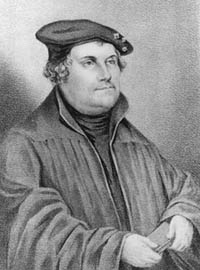  Luther's
anti-Semitic writings, such as On Jews and their Lies
(1543), were frequently quoted by the Nazis to justify their
actions. Julius Streicher, the editor of the anti-Semitic Nazi
newspaper Der Stürmer cited Luther in justifying
his own conduct in the court at Nuremberg in 1946. Luther had
recommended that Jewish schools and synagogues should be burned
down, that the houses of Jews should be destroyed, that their
books should be seized, and public prayer or teaching punished
by death. Luther's
anti-Semitic writings, such as On Jews and their Lies
(1543), were frequently quoted by the Nazis to justify their
actions. Julius Streicher, the editor of the anti-Semitic Nazi
newspaper Der Stürmer cited Luther in justifying
his own conduct in the court at Nuremberg in 1946. Luther had
recommended that Jewish schools and synagogues should be burned
down, that the houses of Jews should be destroyed, that their
books should be seized, and public prayer or teaching punished
by death.
Jews should not be allowed to walk on the streets. Their wealth
should be confiscated. He recommended forced labour, or better
still, expulsion from the country. It was almost a Nazi textbook.
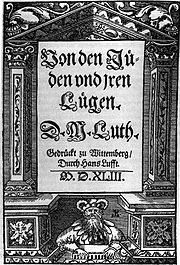  As
a Jewish historian has noted, because of his views Protestants
became even more anti-Semitic than Roman Catholics*.
In the twentieth century German Protestants were still keen
to follow his advice. The Nazis realised all of Luther's dreams,
helped by Deutsche Christen and other Christian Churches.
The Deutsche Christen were Nazi Protestants who dominated
the Protestants in Germany. During World War II over half of
the German Landeskirchen were Deutsche Christen.
But other Protestant Churches held similar views. Here is part
of a declaration made by the Presidents of German Protestant
Churches in 1941: As
a Jewish historian has noted, because of his views Protestants
became even more anti-Semitic than Roman Catholics*.
In the twentieth century German Protestants were still keen
to follow his advice. The Nazis realised all of Luther's dreams,
helped by Deutsche Christen and other Christian Churches.
The Deutsche Christen were Nazi Protestants who dominated
the Protestants in Germany. During World War II over half of
the German Landeskirchen were Deutsche Christen.
But other Protestant Churches held similar views. Here is part
of a declaration made by the Presidents of German Protestant
Churches in 1941:
The National Socialist leaders of Germany have provided indisputable
documentary evidence that the Jews are responsible for this
war in its world-wide magnitude. They have therefore made
the necessary decisions and taken the necessary steps, both
internal and external, to ensure that the life of the German
nation is protected against Judaism.
As members of that same German nation, the undersigned leaders
of the German Evangelical Church stand in the forefront of
this historical struggle to defend our country, because of
which it has been necessary for the national police to issue
a statement to the effect that the Jews are the enemies of
the German nation and of the world, just as it was also necessary
for Dr Martin Luther to demand, on the basis of his own bitter
experience, that the severest measures should be taken against
Jews and that they should be expelled from all German countries.
.... Christian baptism does not change in any way the Jew's
racial character, his membership of the Jewish people and
his biological nature. It is the duty of a German Evangelical
Church to foster and to promote the religious life of the
German people. Christians who are Jews by race have no place
in that Church and no right to a place.
The undersigned leaders of the German Evangelical Church
have therefore decided not to accept Jewish Christians as
members of the Church community*.
This was far from unusual. Other Protestants, who did not support
Hitler, joined the so-called Confessing Church, and in the main
kept their views to themselves. After the war was over and the
danger passed, the leaders of the Confessing Church made a declaration
of their own guilt to the Council of World Churches, a gesture
that was at least more than other Churches were prepared to
do*.
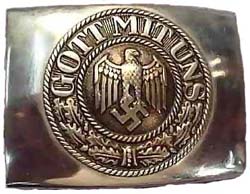  The
Roman Catholic Church had earned as bad a reputation during
the Nazi era, but no declaration of guilt was forthcoming from
its head, Pius XII. Pius appeared to many to have supported
the great dictators. His Holiness never once unequivocally condemned
the victimisation or murder of Jews in Italy or the Third Reich,
despite being blessed with direct communication with the Divine
through his supernatural visions. When Marshal Pétain
asked whether the pope had any objection to anti-Jewish laws
the pope confirmed that he did not. During the war he never
even made a statement that would give guidance to the many Roman
Catholics in the fascist and Nazi armies, as he could have done
without endangering himself. Roman Catholics engaged in genocide
were never once informed by the Church or the Pope that what
they were doing was wrong. In the whole of Christendom only
a handful of churchmen stood up to the Nazis. Altogether, over
six million Jews died, including a million children. As historians
have observed, it is difficult to see how the attempted murder
of an entire people could take place without the highest moral
authority on Earth voicing any explicit criticism of it. A memo
in the records of the British Foreign Office describes Pius
as “the greatest moral coward of our age”. A man
who refuses to risk his own security, knowing that by taking
such a risk he might well save millions of others, seems a curious
choice for God's representative here on Earth. The
Roman Catholic Church had earned as bad a reputation during
the Nazi era, but no declaration of guilt was forthcoming from
its head, Pius XII. Pius appeared to many to have supported
the great dictators. His Holiness never once unequivocally condemned
the victimisation or murder of Jews in Italy or the Third Reich,
despite being blessed with direct communication with the Divine
through his supernatural visions. When Marshal Pétain
asked whether the pope had any objection to anti-Jewish laws
the pope confirmed that he did not. During the war he never
even made a statement that would give guidance to the many Roman
Catholics in the fascist and Nazi armies, as he could have done
without endangering himself. Roman Catholics engaged in genocide
were never once informed by the Church or the Pope that what
they were doing was wrong. In the whole of Christendom only
a handful of churchmen stood up to the Nazis. Altogether, over
six million Jews died, including a million children. As historians
have observed, it is difficult to see how the attempted murder
of an entire people could take place without the highest moral
authority on Earth voicing any explicit criticism of it. A memo
in the records of the British Foreign Office describes Pius
as “the greatest moral coward of our age”. A man
who refuses to risk his own security, knowing that by taking
such a risk he might well save millions of others, seems a curious
choice for God's representative here on Earth.
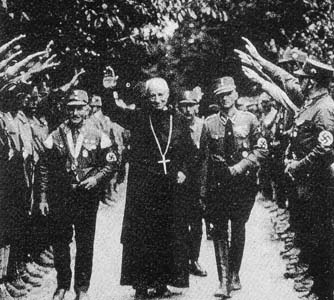  His
Holiness failed consistently to condemn Nazi atrocities, even
though he was certainly aware of them after 1942, and was repeatedly
asked to condemn them. During and after the war he was content
to continue referring to "perfidious Jews". After
the war he even condemned the concept of collective guilt as
applied to the German people. To many this was the ultimate
irony since the Church's persecution of the perfidious Jews
had for centuries been based on the principle of collective
guilt. Pius's successor, Pope John XXIII, admitted Church guilt
in the sort of code favoured by theologians: "The mark
of Cain is stamped upon our foreheads. Across the centuries,
our brother Abel has lain in blood which we drew, and shed tears
we caused by forgetting Thy love. Forgive us Lord, for the curse
we falsely attributed to their name as Jews. Forgive us for
crucifying Thee a second time in their flesh, for we knew not
what we did". This may mean "We admit responsibility
for centuries of persecution and murder", but it is difficult
to be certain. In 1958 His Holiness removed the reference to
"perfidious Jews" from the Good Friday liturgy of
the Roman Church. In 1965 the Second Vatican Council reconsidered
the question of collective guilt and exonerated the Jews from
collective responsibility for the death of Jesus, but only on
condition that they dissociated themselves from the supposedly
wicked generation of the time of the crucifixion. Rarely a senior
churchman will now admit to his Church's complicity. Cardinal
Franz König for example confirmed in 1988 that the Roman
Catholic Church in Austria bore part of the responsibility for
Nazi crimes against the Jews, and admitted that anti-Semitism
was linked to Roman Catholic education practices*. His
Holiness failed consistently to condemn Nazi atrocities, even
though he was certainly aware of them after 1942, and was repeatedly
asked to condemn them. During and after the war he was content
to continue referring to "perfidious Jews". After
the war he even condemned the concept of collective guilt as
applied to the German people. To many this was the ultimate
irony since the Church's persecution of the perfidious Jews
had for centuries been based on the principle of collective
guilt. Pius's successor, Pope John XXIII, admitted Church guilt
in the sort of code favoured by theologians: "The mark
of Cain is stamped upon our foreheads. Across the centuries,
our brother Abel has lain in blood which we drew, and shed tears
we caused by forgetting Thy love. Forgive us Lord, for the curse
we falsely attributed to their name as Jews. Forgive us for
crucifying Thee a second time in their flesh, for we knew not
what we did". This may mean "We admit responsibility
for centuries of persecution and murder", but it is difficult
to be certain. In 1958 His Holiness removed the reference to
"perfidious Jews" from the Good Friday liturgy of
the Roman Church. In 1965 the Second Vatican Council reconsidered
the question of collective guilt and exonerated the Jews from
collective responsibility for the death of Jesus, but only on
condition that they dissociated themselves from the supposedly
wicked generation of the time of the crucifixion. Rarely a senior
churchman will now admit to his Church's complicity. Cardinal
Franz König for example confirmed in 1988 that the Roman
Catholic Church in Austria bore part of the responsibility for
Nazi crimes against the Jews, and admitted that anti-Semitism
was linked to Roman Catholic education practices*.
|
An anti-Semitic Christian cartoon from
1896
The whole catoon is modelled on the Crucifiction described
in the gospels,
but with The American people suffering at the hands of
Jewish controlled institutions.
The titulus attached to the cross reads "This is
US in the hands of the Jews"
|
 |
  Antisemitism
was still a standard part of Catholic teaching into the 1970's.
Over a 30 year period from the 1930's, Father Louis Gales’s
Treasure Chest Comics were distributed to millions of children
in Catholic parochial schools in the US, which promoted Catholic
propaganda against Communism and against Jews, continuing the
slander that there was a vast global conspiracy to destroy the
Christian world. The image on the right is typical, depicting
Jews in the heart of washington as determined to finish off
the Catholics. Antisemitism
was still a standard part of Catholic teaching into the 1970's.
Over a 30 year period from the 1930's, Father Louis Gales’s
Treasure Chest Comics were distributed to millions of children
in Catholic parochial schools in the US, which promoted Catholic
propaganda against Communism and against Jews, continuing the
slander that there was a vast global conspiracy to destroy the
Christian world. The image on the right is typical, depicting
Jews in the heart of washington as determined to finish off
the Catholics.
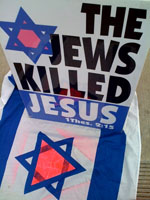  During
their Passover meal many Jews still leave their doors open,
as they have done for centuries. One traditional reason is to
allow in anyone who wants to see what is happening, and in particular
to see that Christian children are not being murdered. Churches
still apparently do their part to foster hatred and distrust.
A detailed study in the 1966 revealed that a significant amount
of anti-Semitism in American Christians was due to Church teachings*.
The doctrine of collective guilt was found to be still popular:
46 per cent of Roman Catholics, 60 per cent of Protestants,
and 86 per cent of Southern Baptists subscribed to the statement
that "Jews can never be forgiven for crucifying Christ". During
their Passover meal many Jews still leave their doors open,
as they have done for centuries. One traditional reason is to
allow in anyone who wants to see what is happening, and in particular
to see that Christian children are not being murdered. Churches
still apparently do their part to foster hatred and distrust.
A detailed study in the 1966 revealed that a significant amount
of anti-Semitism in American Christians was due to Church teachings*.
The doctrine of collective guilt was found to be still popular:
46 per cent of Roman Catholics, 60 per cent of Protestants,
and 86 per cent of Southern Baptists subscribed to the statement
that "Jews can never be forgiven for crucifying Christ".
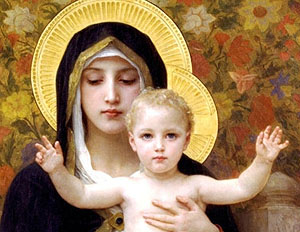  The
Anglican Church stays silent about the martyrdom of St William
of Norwich and Little St Hugh of Lincoln. Their many miracles
still stand testimony to the Christian faith. At the time of
writing there is a notice put up by the cathedral authorities
by the remains of the shrine of Little St Hugh in Lincoln Minster.
It frankly concedes that the story of Little St Hugh and other
such stories were fictions. It goes on to suggest a prayer,
not as one might expect for the victims of Christian persecutions,
nor even for forgiveness. It simply asks God to forget all about
it "Remember not, Lord, our offences, nor the offences
of our forefathers". The
Anglican Church stays silent about the martyrdom of St William
of Norwich and Little St Hugh of Lincoln. Their many miracles
still stand testimony to the Christian faith. At the time of
writing there is a notice put up by the cathedral authorities
by the remains of the shrine of Little St Hugh in Lincoln Minster.
It frankly concedes that the story of Little St Hugh and other
such stories were fictions. It goes on to suggest a prayer,
not as one might expect for the victims of Christian persecutions,
nor even for forgiveness. It simply asks God to forget all about
it "Remember not, Lord, our offences, nor the offences
of our forefathers".
|
A modern Christian cartoon - replaying
the traditional Christian line about the Jews being "Christ-killers"
|
|
|
| |
|
Examples of "Host Nailing"
|
|
|
| |
|
|
| |
|
|
| |
|
|
| |
|
|
| |
| |
| |
| |
|
Stone medallion showing the purported
martyrdom scene of Simonino di Trento with Simon of Trent
positioned in the typical Christ pose
Palazzo Salvadori, Trent,
|
|
|
| |
|
Portrait of St Simon of Trent, 1607,
etching
|
|
|
| |
|
St Simon of Trent
|
|
|
| |
|
Simon of Trent, School of Niklaus Weckmann,
1505–15,
Museo Diocesano Trentino, Trento, Italy.
|
|
|
| |
|
Coloured 15th century woodcut showing
Jews murdering the child Simon of Trent. In Hartmann Schedel,
Nuremburg Chronicle or Buch der Chroniken, printed by
Anton Koberger in 1493.
The round yellow patches are badges that Jews were forced
to wear.
Names of protagonists are labeled.
|
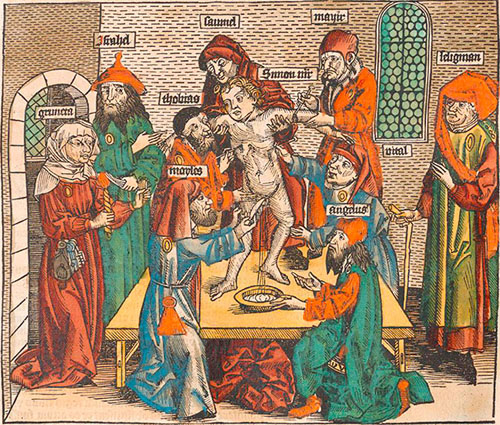 |
| |
|
15th century woodcut showing Jews murdering
the child Simon of Trent (detail). In Hartmann Schedel,
Nuremburg Chronicle or Buch der Chroniken, printed by
Anton Koberger in 1493.
The round patches are (yellow) badges that Jews were forced
to wear.
Names of protagonists are labeled.
|
|
|
| |
| |
|
|
|
|
|
|
|
|
|
|
|
|
|
|
|
|
|
|
|
|
|
|
|
|
|
|
|
|
|
|
|
|
|
|
|
|
|
|
Buy the Book from Amazon.com
|
|
|
|
|
|
Buy the Book from Amazon.co.uk
|
|
|
| |
| |
| More Books |
|
|
|